Keeping Your Baby Cool in the Hot Weather

As summer finally arrives, the sunshine can be a joy, but for new parents it often brings a wave of questions about how to keep babies safe and comfortable in the heat. Babies are less able to regulate their body temperature than adults, so it's important to be aware of simple ways to keep them cool and avoid overheating.
With a background in physiology and over a decade of experience running baby preparation classes in SW London, I’ve helped thousands of local parents navigate the ups and downs of life with a newborn. Here's a practical guide with tips I often share in my classes simple, reassuring steps that make a real difference in hot weather.
Daytime Tips
- Stay indoors during the hottest part of the day
- If you're heading out, stick to shady areas and avoid keeping your baby in the pram for long periods. Prams can become surprisingly hot, even in the shade.
- Use a pram parasol or clip-on fan rather than covering the pram with a blanket or muslin, which can trap heat.
- Keep curtains or blinds closed in your baby’s room during the day to block out the sun and reduce room temperature.
- Use a fan to circulate air before bedtime - avoid pointing it directly at your baby.
- Placing a bowl of ice or frozen water bottle in front of the fan helps cool the air even more.
- If the room is consistently hot, consider moving your baby to a cooler room in the house for sleep.
- Bedtime Routine
- A cool bath before bed can help lower your baby’s core temperature and make them more comfortable for sleep.
- Dress your baby in very light clothing - often just a nappy and a 0.5 tog sleeping bag is enough.
- Always check your baby’s temperature by feeling the back of their neck or chest. If they feel sweaty or hot, adjust layers.
Hydration Tips
- If you’re breastfeeding, your baby may want to feed more frequently to stay hydrated. This is normal and helps regulate their body temperature.
- For bottle-fed babies over 6 months, you can offer small amounts of cooled, boiled water in between feeds.
- And don’t forget to stay hydrated too if you’re breastfeeding.
- Spotting Overheating
Look out for signs that your baby might be too hot:
- Hot, flushed skin
- Rapid breathing
- Unusual fussiness or lethargy
- Damp hair or skin
Heat Rash (Prickly Heat)
- This common rash often appears as tiny red bumps on the face, neck, back, or nappy area.
- Keep your baby’s skin cool and dry, change nappies frequently, and use breathable clothing.
- Speak to a pharmacist - they may recommend a gentle zinc-based cream or calamine lotion (if older) to soothe irritation.
Out and About - Car Safety
- Always check the temperature of car seats, buckles, or straps before putting your baby in.
- Never leave a baby in a parked car, even briefly.
- Use sunshades in the car and dress your baby lightly.
My classes at The Baby Care Company are designed to give you the confidence, tools and knowledge you need to navigate life with a newborn or with two little ones in tow.
If you're expecting again and wondering how to juggle the needs of a toddler and a baby or simply want to feel more prepared, my Second Baby Preparation Classes in SW11 (and nearby) are full of practical strategies, evidence-based guidance, and connection with other local parents.
Stay cool and enjoy the summer with your little ones,
Eilish

Anxiety disorder during pregnancy, guest post by Dr Lucinda Green
Worried about your anxiety disorder during pregnancy?
Priory expert advises on how to take care of yourself and your baby
For women with anxiety disorders who are concerned about the impact it will have on themselves and their child during pregnancy, Dr Lucinda Green, Consultant Perinatal Psychiatrist at Priory Wellbeing Centre Harley Street, has advised on how they can take care of their mental health at this time.
It is common to be anxious about many different things in pregnancy, including the possibility of having a miscarriage, coping with childbirth and the challenges of motherhood. Anxiety as a symptom can also be part of a mental illness, including panic disorder, generalised anxiety disorder (GAD), obsessive compulsive disorder (OCD), phobias and post-traumatic stress disorder (PTSD). Anxiety symptoms are also common in depression.
Women are twice as likely as men to be affected by an anxiety disorder during their lifetime.[1] At least 15% of women have an anxiety disorder during pregnancy.[2]
“It is important for women who have an anxiety disorder to think about the care and treatment they need during pregnancy”, says Dr Lucinda Green, a Consultant Psychiatrist at Priory Wellbeing Centre Harley Street.
“Pregnancy is not protective against mental illness. Having a previous anxiety disorder can increase the risk of this happening in pregnancy. However, having a current or previous anxiety disorder doesn’t mean that you will definitely become more anxious. Having good support, positive coping strategies for stress, and treatment if you need it, can all help you to manage your anxiety and prevent it worsening in pregnancy.”
Don’t suddenly stop taking your anxiety medication
Dr Green recommends that women with anxiety disorders talk to their GP or psychiatrist who can help them to weigh up the risks and benefits of medication during pregnancy.
“Decisions about whether to continue, stop or change medication in pregnancy are not straightforward.
“Selective serotonin reuptake inhibitors (SSRIs) antidepressants, such as sertraline, fluoxetine and citalopram, are the most commonly prescribed medications for anxiety. Many women take these medications in pregnancy. If your anxiety has been severe, causes a lot of distress, or impacts on your ability to manage everyday tasks, it may be best for you and your baby that you continue medication.”
Dr Green explains that, where possible, it’s important to have this conversation when planning the pregnancy, but if this isn’t possible, don’t worry: “Many pregnancies are unplanned so don’t worry if you haven’t managed to get advice about your medication.
“Many women have to make decisions about medication when they are already pregnant. You should not stop your medication or reduce the dose without discussing this with your doctor. Stopping medication suddenly can increase the risk of relapse.”
The impact of your anxiety on your pregnancy and baby
Many women worry about how their anxiety will affect their baby and this can make them even more anxious.
Dr Green says: “The research in this area is complex. Whilst there are studies which show that anxiety in pregnancy can have a lasting impact on babies, there are many different factors which will affect your baby’s wellbeing and development.
“Having an anxiety disorder does not mean that your baby will necessarily have problems later on. How you care for your baby after birth is very important. Getting treatment for an anxiety disorder so that you are as well as possible when your baby is born will help to make sure that he or she has the best start in life.”
For women worried that they may pass on their anxiety to their child, Dr Green says: “Anxiety disorders are caused by a combination of factors. Having a parent with an anxiety disorder is one of these, but it accounts for only around a third of the risk. So if you have an anxiety disorder it does not mean that your child will develop the same problems.”
Dr Green’s tips on managing anxiety during pregnancy
“There is a lot of help and support available for women who have anxiety and other mental health problems in pregnancy”, says Dr Green. “The help you need will depend on how severe your anxiety problems are. Talk to your midwife and GP to find out what help and support is available in your area.”
She also encourages women to consider the following suggestions:
1. Make time to relax – make time to do things you find relaxing, whether this is going for a walk with a friend or having a hot bath
2. Practise mindfulness – accessible through groups and apps such as Headspace, this helps you to focus on the present moment rather than worrying about things in the past or the future. It has been shown to be helpful for anxiety
3. Exercise – physical exercise can make a difference to anxiety. Talk to your midwife about exercises you can do in pregnancy, such as swimming or yoga
4. Look after your physical health – sleep and rest when you can, eat healthily and make sure you get treatment for any physical health problems
5. Avoid alcohol and drugs - these can make anxiety worse and importantly, can also cause significant harm to your unborn baby
6. Talk - it can be a relief to share your worries with someone you trust
7. Source support groups and helplines – ask your midwife or GP about local support groups for women who have anxiety in pregnancy. You can also contact one of the organisations listed below
8. Prepare for the birth – going to antenatal classes and making a birth plan with your midwife can help you feel more in control and reduce the anxiety you have about birth
9. Attend talking therapies – ask your GP to refer you for a talking therapy, such as cognitive behavioural therapy (CBT). You can self-refer to your local Improving Access to Psychological Therapies (IAPT) service for talking therapies. IAPT services usually give priority to women who are pregnant or who have a young baby
10. Talk about medication – talk to your GP or psychiatrist about using medication if your anxiety disorder is severe or does not respond to a talking therapy
11. Access your perinatal mental health service - if you have a severe mental health problem, you can be referred to a perinatal mental health service. This is a service with a team of mental health professionals who specialise in caring for women who have mental health problems in pregnancy and after birth
Further information, help and support
· Tommys - information about anxiety and panic attacks in pregnancy
· Netmums - information about anxiety and peer supporters offering advice and support online
· Maternal OCD - information and peer support for women with perinatal OCD. Peer support via phone, skype and email
· PANDAS Foundation - information and support, including a helpline and email support, for women experiencing anxiety and depression in pregnancy or the postnatal period
· Mind - information about perinatal anxiety
· Birth Trauma Association - information and support for women who have PTSD due to a traumatic birth
· Best Beginnings - videos of women describing their experience of antenatal and postnatal mental health, and treatment. Also available on the Baby Buddy App
· Headspace - meditation and mindfulness information and guidance
Tips for keeping your baby cool in the hot weather
DAYTIME
Try to stay in for the hottest parts of the day.
If you do go out, make sure you stay in the shade and don’t leave your baby in the pram for too long as it can get very hot in there.
Keep the curtains closed in your baby’s bedroom during the day
BEDTIME
Just before bedtime use a fan to recirculate the air in the room but try not to point the fan directly at your little one.
A cooler bath before bedtime can help cool them down.
Dress them in very few clothes. If it’s really hot they may only need a nappy and a very light sleeping bag (0.5tog)which is more like a sheet.
KEEPING HYDRATED
If you’re breastfeeding, you might find that your baby wants to feed more often to keep hydrated.
For bottle fed babies over 6 months they might like some cooled boiled water in between feeds.
HEAT RASH (Prickly heat)
You may notice that your baby gets a prickly heat rash. I’d suggest going to the pharmacist to see what cream they recommend to help with the itch/sting of the rash. Usually it will be a cream containing zinc. Changing their nappy more often can also help as the rash often occurs where the skin is more moist.
Keep Cool,
Eilish

Yoga in pregnancy
I practiced yoga in both my pregnancies and found it a great way to relax and help strengthen my body. One of the mums that came to my 2nd baby class and who has just had her 3rd child got in touch raving about Erika’s classes, so after I met Erika, I thought I should share her details and let her introduce you to yoga during pregnancy.
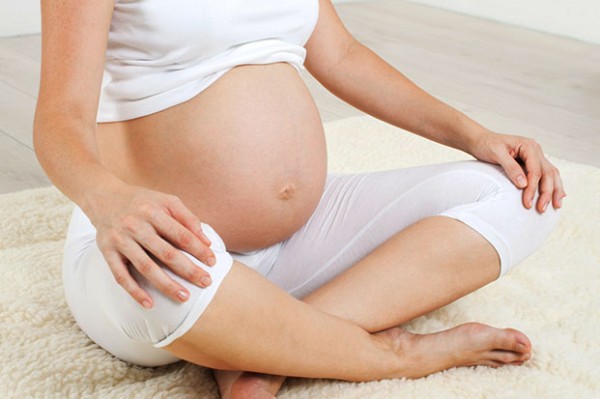
Yoga during pregnancy
Pregnancy is a time of huge change for women on a physical, mental and emotional level. Yoga is a wonderful tool to support future mums through all the transitions going on.
Who can practice yoga?
Yoga is suitable for all women during pregnancy unless there are any health contra-indications. These will be addressed through a confidential questionnaire. It is normally advisable to take up a yoga practice after 12 weeks, as the first trimester is a time when it is best to rest and take it easy. This advice might be slightly different for those who have a long-term yoga practice, but will vary slightly from instructor to instructor.
Why do I need to join a prenatal yoga group, rather than a general class?
A prenatal yoga class will cater for all the changes that are happening at all levels. It will focus on the physical, mental and emotional changes that are prevalent in pregnancy. A prenatal yoga instructor will be qualified and trained to deliver a safe class both for mum and baby. A number of teachers will integrate expectant mums into general classes, but usually only if the mum to be has had a long term established practice. As a beginner to yoga, it is best to join a dedicated pregnancy yoga class, as this will be the most beneficial and safe practice for mum and baby.
What will the yoga class involve?
A pregnancy yoga class will focus on strengthening and stabilizing the parts of the body that need to be strong to support the additional weight of the baby. One will also practice gentle exercises to release the tension that can build up in this transforming body. Postural alignment will be addressed and relaxation and breathing techniques will be integral parts of the practice. The yoga practice will usually have a physically challenging part, balanced with relaxation and tension release practices, all devised to support body and mind throughout the trimesters of the pregnancy.
What are the benefits of yoga in pregnancy?
Prenatal yoga offers many benefits to pregnant women:
If you have any additional questions about yoga in pregnancy that have not been answered through this blog, feel free to get in touch at info@yogiyoga.co.uk
Erika teaches group, private and corporate yoga classes in South West and Central London. After a long career in the corporate world, Erika qualified as an RYT500 Yoga instructor in 2010. Her classes are energetic, yet leaving space for her students to practice mindfulness and awareness. The practice balances strength with flexibility, movement with stillness. There is a strong emphasis on pranayama and alignment, with the purpose of restoring the body’s energetic flow and creating balance. Erika thrives from seeing students grow, progress and flourish from the benefits they reap from their yoga practice.
Erika teaches vinyasa flow, gentle flow, prenatal and post-natal yoga, meditation, pranayama and restorative yoga.
She started a new prenatal yoga class at Local Motion Southside on January 22nd 2015 and is available for private tuition at her studio or your home. For information, please click on www.yogiyoga.co.uk or www.localmotionstudios.com
Birth Cover for when you go into labour with your 2nd, (3rd or 4th) baby...Hello Mums comes to the rescue
Help is at hand however with the introduction of Hello Mums birth cover service.
Here Kate Wilson who runs Hello Mums tells us more.
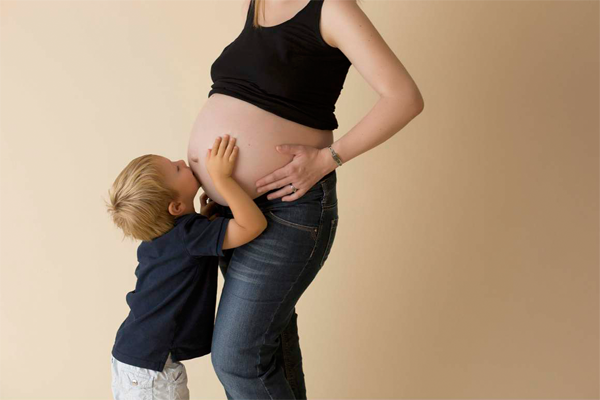
Photo : Emanuela Redaschi photography
At Hello Mums we know just how important it is to have an emergency birth cover ready on the other side of the telephone to come and take over when your water breaks and you need to rush into the hospital.
It is not an easy scenario and that is why we have a devoted team dedicated to birth covers, so you don't need to worry about the little ones you leave at home behind.
Our guidelines are determined by your request which means that when you decide to use a birth cover we will come and have a long chat with you so we know exactly what cover you will need and we have a standard list of questions and thoughts that we will ask from you. We will need you to let us know everything you might wish us to cover as it is just as important for us to be prepared as it is for you. After all, there are many ways to give birth and we need to be aware of your options and where you stand.
In general, most birth covers are restricted to two or three professionals who are all aware of your due date and your requirements and have done this type of cover many times. Depending on what you need we will arrange for you and your little one to meet the person doing the Birth cover - not just to give you a peace of mind but also for the child to meet the person who will be taking care of him/her whilst mummy is away.
In the majority of the cases the birth cover happens during the night and lasts about 12 hours or until a family member can take over and look after your child (children). All of our ladies who specialise in Birth covers have done this many times and are all aware of what it means to be on call, so they know that just because your due date is on the 5th you will not necessarily go into labour till then (wouldn't that be just great?! But babies don't work like that and we are well aware of that!)
So help is here and once you are back home and recovered from welcoming a new precious one into your lives and hearts we will be ready to provide the evening babysitter as well so you can have some time off with your partner.
Best of luck and I wish best of health for the newest member of your family and to you all.
Kate, Hello Mums
x
What to do if your baby was choking - guest post by Emma Hammett of First Aid for Life
This article has been written by Emma Hammett who set up and runs First Aid for life. Having been to her classes, I thought you’d appreciate some tips on the very scary subject of what to do if your baby started choking.
Choking is scarily common and it is extremely frightening to see your little one struggling to breathe and feel powerless to help.
Babies put everything in their mouths and anything fits through a loo roll can be a potential choking hazard for them. Weaning can be a stressful experience as babies have a very sensitive gag reflex and often appear to struggle when trying new food textures. If they appear to be choking; repositioning them head downwards can help. If repositioning them does not work, give firm back blows as shown below. If they are able to cough, let them clear the obstruction themselves – if they are quiet and struggling to breathe, help immediately.
When starting solids; avoid slicing food into perfect circles as these can block the airway completely if they get stuck.
Choking – how to help
1. Stay as calm as you can.
2. If they are able to cough, reposition them to see if they can clear it themselves.
3. Have a quick look in the baby’s mouth and carefully remove anything obvious. NEVER blindly sweep inside the baby’s mouth with your fingers as it can cause damage and push the obstruction further down.
4. Lay the baby downwards across your forearm, supporting under their chin.
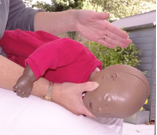 
5. With your hand hit the baby up to 5 times firmly between their shoulder blades
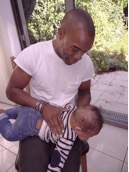
6. Check after each back blow to see if the obstruction has cleared
7. If still choking; lay the baby on its back across your knees, head downwards. Place two fingers in the centre of their chest at the nipple line, and give up to five, firm upward chest thrusts
8. If the baby is still choking, call 999/112 and continue giving baby five back blows, alternated with five chest thrusts, until help arrives
9. If the baby becomes unconscious start CPR immediately.
It is strongly advised that you attend a Practical First Aid course to understand what to do in a medical emergency. Please visit www.firstaidforlife.org.uk emma@firstaidforlife.org.uk or tel 0208 675 4036 for more information about their courses.
First Aid for life provides this information for guidance and it is not in any way a substitute for medical advice. First Aid for Life is not responsible or liable for any diagnosis made, or actions taken based on this information.
First Aid for Life is an award winning First Aid training business that is HSE and Ofqual Approved through Qualsafe Awards. Our trainers are medical and emergency services professionals and our training is tailored to your needs
Tips on Toddler tantrums
It can be quite a shock when our precious little angel starts to behave like those older children we’d seen in the playground only a few months before, or when our darling son goes up and hits a stranger on the head or sinks his teeth into an arm in frustration.
Unfortunately tantrums will be part of life for all our toddlers to one extent or another, so I thought I’d give you my tips on ways of handling them or trying to avoid them.
Firstly it’s important to say that temper tantrums are totally normal and form part of the growing up and learning process. There seems to come a point when our little people want to express their independence and test the boundaries to see how we’ll respond.
Factors affecting tantrums
Most toddlers exhibit some degree of tantrums from the age of 18m-36m. This could be anything from screaming, kicking, running off, falling to the ground or crying.
Hunger and tiredness can play a big part, as can overstimulation or frustration at what another child is doing e.g. pinching a toy, or at being unable to express what they want.
The character of your child also plays a big part, as can being told NO or what to do all the time. You could allow your little one more independence by giving them ‘controlled’ choices e.g. would you like to wear the blue or red top, or shall we go to the café or the swings?
What can you do to help ?
1.Try to ensure your child has regular mealtimes and naps where possible, as a hungry and tired child is much more prone to tantrums.
2. If you can spot a tantrum on the way, try to catch it before it happens and distract your child with something else.
3. Try to remain calm (even if you don’t feel it!)when your little one is trantrum-ing as shouting or being aggressive towards them can often makes things worse and escalate out of control. If you can’t avert it, it’s best to wait until they have calmed down to reason with them.
4. Pick your battles and be consistent. If the tantrum is caused by your child not getting something, don’t give in to stop the tantrum.
5. Give positive, descriptive praise. If your child has done something well, be specific when you praise them. For example if they’ve put their shoes on by themselves, don’t just say ‘good girl’, instead say ‘ wow that was brilliant the way you managed to put on your shoes all by yourself,’ That way she understands exactly what you were praising her for and will hopefully do it again! Similarly if she draws a picture and asks what you think, be specific about what you like e.g. I really liked the way you drew the sun - bright yellow and round.’
6. Don’t give the tantrum too much attention. If your little one has hit another child, don’t give your child all the attention. Instead focus on the other child and how they are feeling. By focusing on the hurt child, your child will see that hitting doesn’t get your attention, instead it gets them less.
7. Be reasonable and find out why your child might have hit someone. For example it may have been that they had their toy pinched or they were pushed first and they are just retaliating. Make sure that the other child’s behavior is addressed if they are also in the wrong otherwise you’re sending out mixed messages that can lead to even more frustration.
8. If your little one is playing happily with others or by themselves, comment on how well they are playing. This way they are getting your attention for being good, rather than you just getting involved when things go wrong.
9. Be consistent with your response to tantrums and agree the way you’re going to handle it with your partner so your toddler knows what to expect. It can be very confusing for the child if their mum and dad have different rules and different approaches.
10. Sometimes tantrums can occur when your child doesn’t want to go somewhere or stop what they’re doing. Help them understand what’s coming up by giving them advance notice eg in 5 mins we’re going to have a bath so I’d like you to come upstairs with me then, OK.
It can be really exhausting and emotional dealing with tantrums, but the good news is that tantrums won’t last forever and they get better as your child gets older. Good luck! Eilish

Back to Work: should I stay or should I go?
Back to Work: should I stay or should I go?
Returning to work or deciding to work from home is a huge decision for a lot of parents. Not only do you need to consider your career and personal life, you also need to consider the financial implications. If you do return to work, does your salary outweigh the cost of childcare? If you want to work from home, will you be earning enough to live comfortably and will this be an extension of your previous career or a brand new venture? Consider the pros and cons extensively before making a decision.
Striking a balance
Firstly, you need to work out if you’ll be able to balance your life at home with your family with your career without neglecting one or the other. If you’re prepared to work late, you may have to be prepared to miss a few bedtimes here and there. A way to get around this is to work evenings from home so you don’t miss out on spending time with your little one.
Consider childcare
Childcare isn’t cheap if it’s full time. However, if you’re earning more at work than the overall cost, it’s worth returning if this is what you want to do. If not, see what the possibilities are from home.
Financial help
If you are finding it difficult to manage financially, you are probably entitled to help. Child benefit and child tax credit are available to most and can cover the smaller costs which come with having a baby.
Another way to manage your finances is to set a budget. This budget may include childcare if you’re going back to work or weighing up your expenses if you were to stay at home. Try working this out, if you can, before the baby arrives in order to minimise stress and potential debt.
Pregnancy massage (incase you need an excuse..)
I’m a fan of a massage and like to have Jo or one of the other experienced HomeSpa London (insert link http://www.homespalondon.co.uk/) therapists come to give me a massage in the comfort and convenience of my home when I can (while my little one plays nearby), but I’ve never had a pregnancy massage before.
I generally like quite a deep tissue massage and so I was interested to see how it would be different, how I would feel afterwards and what the health benefits are.
The main differences in the set-up are that a pregnancy masseuse is careful about the oil she uses (Jo used a natural massage balm suitable for pregnancy), it’s a full-body treatment save for your stomach and certain ‘trigger points’ (which you might like to have activated close to your due date!) and you’re positioned differently – either on your side, bolstered comfortably with pillows at your shoulder and legs as I was at home, or on a specially designed bed with a cut-out area to allow you to be on your front without any pressure on your bump.
I’ve been pretty lucky in my pregnancy so far, aside from a little muscle stiffness between my shoulders and lower back. The pressure of Jo’s massage, is a little less than pre-pregnancy but still strong and certainly enough to give that feeling of working and relaxing the muscles.
Pregnancy prompts lots of changes to the physiology of your body; muscles and tendons relax and stretch, your centre of gravity changes, which can prompt muscle tension (especially in your upper back, shoulders, lower back and hips) and swelling in your extremities is also common.
A pregnancy massage, whilst reducing emotional stress, also serves to simulate circulation, which distributes nutrients to vital organs, helps lower or keep blood pressure balanced and an added benefit is that massage releases oxytocin, the pain reducing hormone – which could provide relief of pain during labour if you time it right.
I felt incredibly calm and relaxed after the massage – in fact I could have gone straight to sleep afterwards – and the stiffness in my muscles was completely alleviated.
Aside from the fact that I felt great, I love that research suggests that the baby can benefit from massage too, as 'feel good' endorphins released during the massage are passed onto the baby. It’s also quite common that your baby will wriggle and kick as it, too, responds to the massage treatment.
I’d definitely recommend a pregnancy massage as a lovely way to relax, to bond with your unborn baby and to help ease some of the common ailments associated with the stresses and strains of your changing body. Massage is recommended from three months of pregnancy.
By Alicia Stewart, Editor ClaphamMums.com, at 23 weeks pregnant
Potty training - being dry at night
Many mums in my 2nd baby preparation classes ask when their toddlers should stop wearing nappies at night?
As with potty training in the day time, I find this is very child-dependent. Some parents find that when their toddlers are dry in the day, they don’t then want to wear nappies at night either, but for most this isn’t the case and so I’d treat day and night time dryness separately.

Why might it take longer to be nappy-free at night?
A hormone called vasopressin works to concentrate the urine so that it doesn’t take up so much room in your bladder (stopping the need for you to wee at night). For many toddlers this isn’t produced in high enough concentrations until they are 3 or 4+ years old.
Others sleep very deeply and therefore they find it hard to wake up to go to the toilet when they’re younger.
Signs your child might be ready.
If they wake up with a dry nappy for about a week.
Some toddlers only wee in their nappy in the morning so if their nappy is wet but still warm (!) they may also be ready.
How should I go about it?
Initially I’d try to restrict drinks after tea time e.g. after 5.30/6pm
Make sure they do a wee before they go to bed – some even do one before and after stories, so give them the opportunity if they want to.
Put a plastic cover on their bed incase they do have an accident, to protect the mattress.
Leave a potty in their bedroom (on an absorbent pad incase their aim isn’t great) with a night light incase they need it. Alternatively, leave their door open with a night light on incase they’d prefer to go to the bathroom.
I personally wouldn’t lift your child before you go to bed as this may train them into going at the same time every night. If you feel you want to, or if you have a really deep sleeper who you think needs to be lifted initially, I’d suggest waking them up so they know that they’re going to the toilet, and changing the time you lift them if you can.
Make sure you have spare bed sheets to hand and spare PJs incase they do have an accident.
Try not to make them feel bad if they wet the bed, and instead just change them and the bed.
Hope that helps. If you have any particular questions, just email me info@thebabycarecompany.co.uk
Your baby's milestones part 2 (6 months +)
This is part 2 of some of the key baby milestones, and this time we’re looking at milestones from 6 months old.
It’s important to remember that babies don’t all develop at the same rate, and so may pick things up faster or slower than others. If you’re worried about anything, it’s always worth going to see your GP.
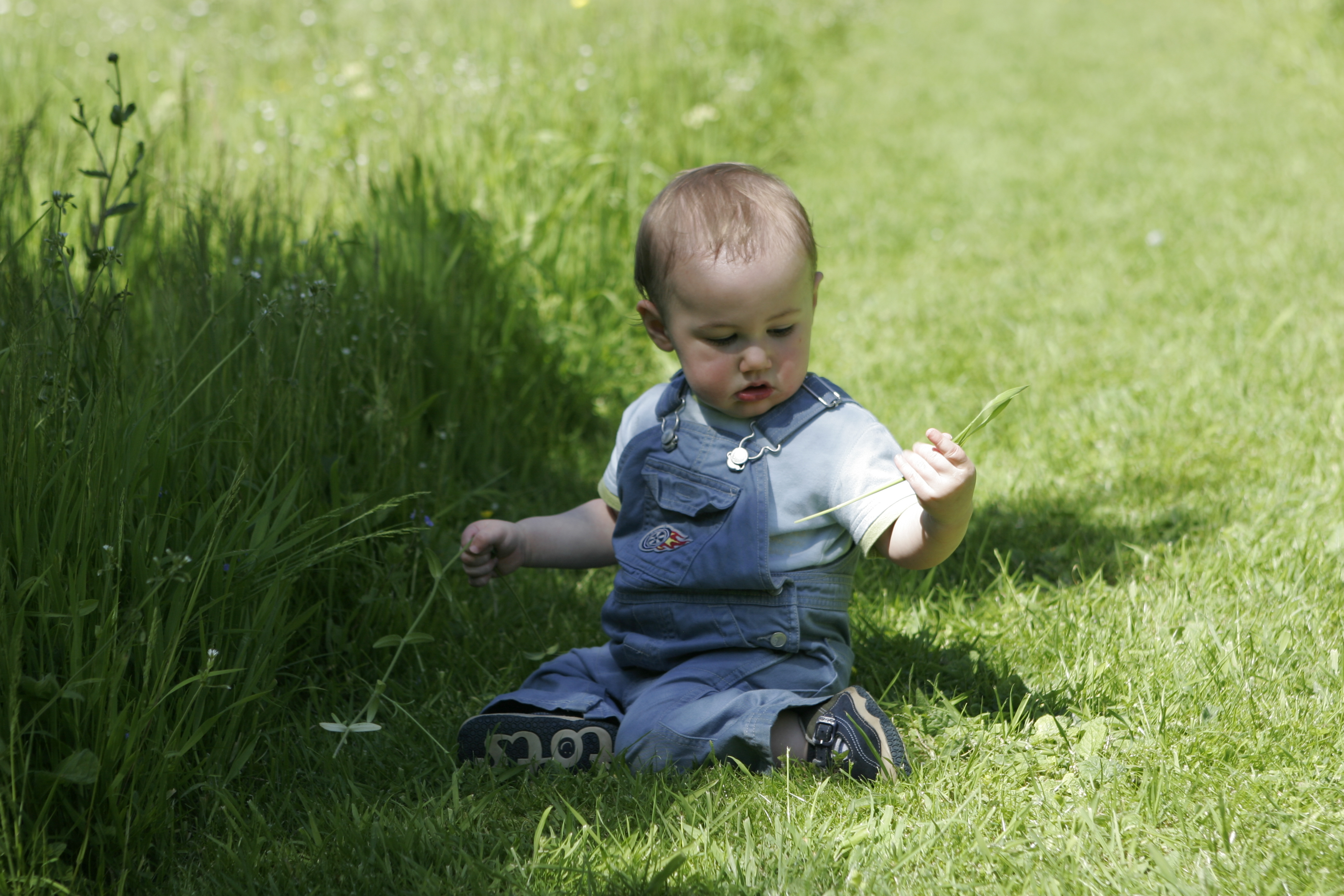
The milestone: Weaning
By six months you’ll need to start introducing solid food. You may find that she is no longer satisfied by milk and that she’s starting to show interest in the food that you and others are eating. Your baby needs it to build up nutrients in her body, as well as to help develop muscles and coordination in her mouth, which is essential for talking.
The milestone: Separation anxiety
At around 7 months to a year, your child will start to become aware that you are a separate person from her and that means when you go away, realizing that you don’t
By 8-9 months babies have enough strength to be able to sit up by themselves. Help them master this skill by putting them on their tummy to help their neck and back to grow stronger. While they’re still unstable, put cushions around them incase they topple over.
The milestone: Pincer grip
The pincer grip is when your child can hold something between her thumb and index finger and shows much greater finger dexterity. This usually happens between 8 to 12 months. Help her practice this useful skill by giving her small items to pick up – leave peas on her highchair tray, for instance.
The milestone: Crawling
Not every baby crawls, but those that do tend to start at around nine months and will very quickly start shooting off all over your home. Many start to crawl backwards before moving forwards. Now is the time to get the baby gate out and start baby proofing your house. You can encourage crawling by putting your baby on her tummy for small periods of time even from a young age, and by putting her favourite toy just out of reach to entice her to crawl and get it.
The milestone: Standing/Cruising
Whether your baby loved to crawl, or passed this stage in favour of ‘bum shuffling’, at some point she’ll get on her feet. Then probably fall back down again. This normally happens at around 10 months.
Cruising is when she takes this ability one step further and will ‘walk’ around while holding onto furniture. Cruising helps your baby learn to balance and helps to strengthen her lower body. It’s helpful to hold onto her hands while she practices standing and walking.
The milestone: Talking
From around 4-6 months your baby will have been babbling – copying the kind of sounds you make to practice for the real thing. Usually, you’ll only get real words at around 12-18 months when they’ll have about 20 words in their vocabularly. You’ll find that even though they can only say c. 20 words, they’ll understand many more.
The milestone: Walking
This is a huge milestone for most parents, who’ll want to capture the moment, and often happens around your baby’s first birthday, though any time from about 10 months til 18 months is normal. At last, your baby will have managed to coordinate her balance with the action of putting one foot in front of the other. Help her practise this life-long skill by holding her hands while she walks around the room. You can also help her practice by encouraging her to walk a few steps between Mummy and Daddy.
The milestone: Potty training
Many children start to be potty trained at 2.5years old, but some are closer to 3. Your child will need to be able to tell the difference between wet and dry, know when they need to go to the toilet and also be able to communicate this to you. Be guided by your child as to when they are ready to start, and try to approach it with a relaxed manner and when there aren’t other major things happening.
For night time dryness, there is a hormone which signals to your body to stop making urine at night and many only have the right levels of this hormone after the age of three. Up until the age of five, accidents are therefore common.
Preparing to become a mum - one mum's story - guest blog by Elena Cimelli, of The Contented Calf Cookbook
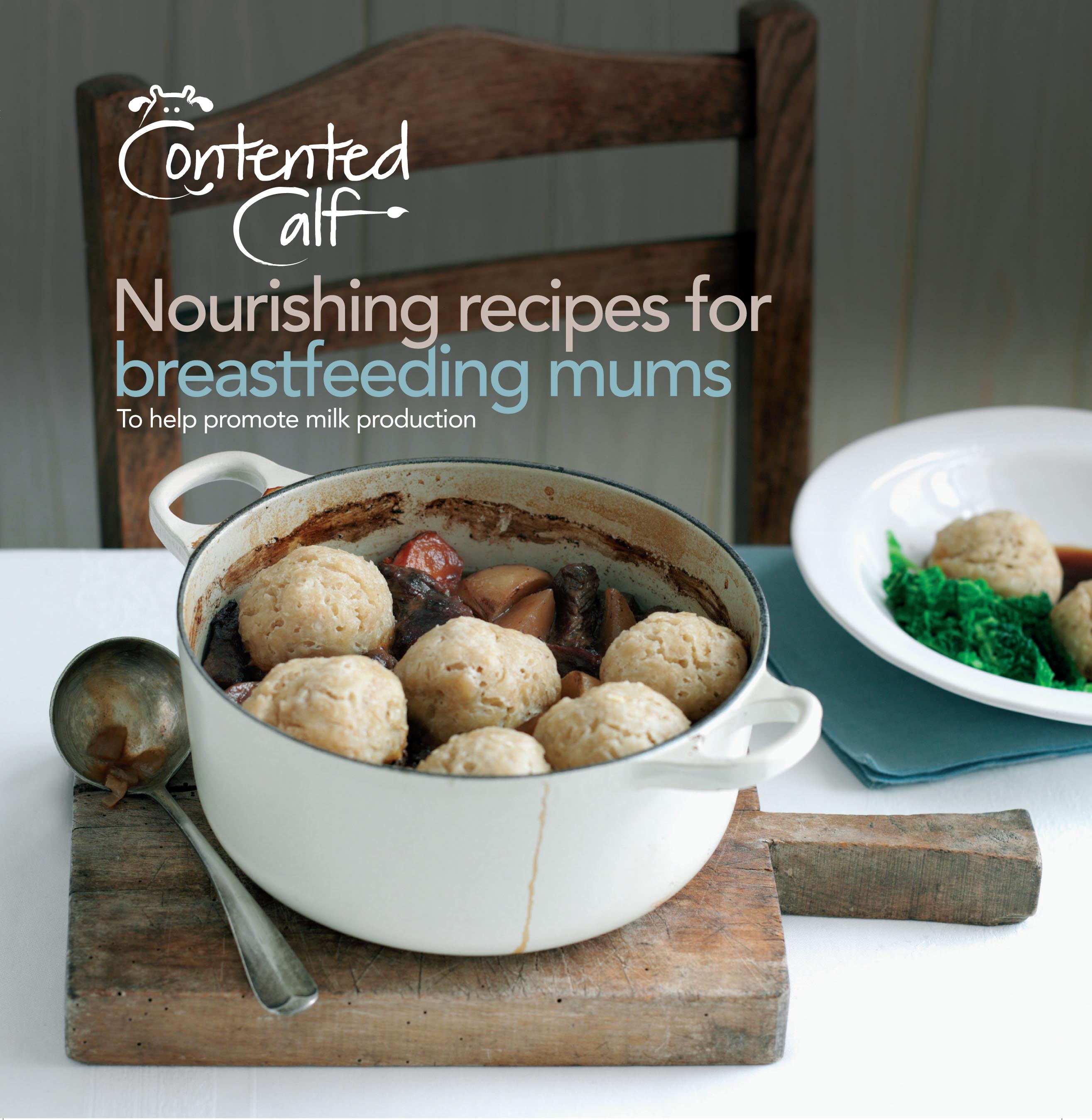
This blog has been written by Elena Cimelli who came up with the idea of producing a cookbook for bread feeding mums, with recipes to help support your milk production. I hope you find her story and journey interesting.
As Eilish says, having a baby is a wonderful emotional experience, but it's also lots of hard work. It's very easy to believe that everything will just slot into place after birth. So many successful, confident women struggle with their newborns, feeling bewildered and overwhelmed as they just focused on the birth, and not the looking after a newborn baby part.
This was is me. Totally. Completely.
In my case, we were up for 41 hours, with a labour of 27 hours and then had two nights of only four hours sleep - followed by having a baby who would not sleep in the day. The first few days were never going to be anything else other than that of survival. After the initial shock, we got into a routine, which helped bring a comforting sense of order and the ability to claw back some sort of control. And for a while I felt like I was getting ‘on top’ of things.
But then followed months of grizzles and whinging, which slowly but surely got back on top of me. It felt like another series of unanswerable questions and challenges to overcome. Then it hit me – I realised it wasn’t just a case of ‘getting through it’ and out the other side: this was being a mum. I was in it for the long term. It took me a long time to really feel like I was a Proper Mum. Nearly four years on, I’m getting there. You can read more here:www.contentedcalf.com/news-and-views/it-takes-nine-months and http://www.contentedcalf.com/news-and-views/second-time-mum.
There are however, many things you can do while you’re pregnant to make those whirlwind first few months easier - get the facts you need, and the practical tips and tricks to help you in those early days.
Before I had my first daughter, friends with babies extolled the virtues of antenatal classes. They were right – through mine I met a truly wonderful group of friends. We’ve supported each other through our ups and downs and general experiences of ‘Mummydom’. Almost four years on and now all with two or more little ones, we are firm friends, still getting together most weeks. Long after most of what we talked about in our antenatal classes has drifted out of my horrendously sieve-like mind, the friendships have remained.
That said, two things our teacher said did manage to stick:
One: “You’ll find yourself more obsessed with, and talking about, poo than you could ever possibly imagine". I don’t need to comment further on this as every parent will know this to be true. Those are still in the ‘to be’ category – be prepared!
And two: “Prepare and freeze as many meals as you can ahead of the baby being born, so you have something quick, easy and nutritious to eat when you are tired beyond belief”. My husband (and I to an extent, but I think this piece of advice sparked off some primeval ‘hunter-gather’ instinct in him) took this to an extreme and we ended up with around 50 meal portions in our freezer before our baby was born - they lasted us for months!
These meals were invaluable for us. We could have nutritious, home cooked food every night, simply by turning on the oven and heating it up.
The birth of The Contented Calf Cookbook
Although she expressed from the offset, one of my friends faced a real battle moving her son from being bottle fed to her own goal of him being fully breastfed. He’d spent his first week in Special Care Baby Unit, which had totally knocked her milk supply.
With a breast pump in one hand and her mobile in the other, she did what any mother does, and spent hours upon hours Googling. She found out about Lactogenic foods and herbs, which can help promote milk production. When her husband went away for a week, I (also being a mum and unable to make any decision or find anything out without consulting Google) took to Google and found some recipes using ingredients from this list of foods. I made her a couple of dishes she could put in the fridge or freezer and just heat up when she needed.
And that’s how the concept of The Contented Calf Cookbook came about. What new mums need is healthy, nutritious, home-cooked food. And if those meals can be made from lactogenic ingredients, which help support their milk supply if they’re breastfeeding, then even better. And if you can cook and freeze those dishes ahead of time, and simply reheat when the baby arrives, better still.
I began researching in a lot more detail, in particular drawing from the great wealth of information about lactogenic foods and herbs in “Mother Food”, along with the book “Making More Milk” – both of which I can recommend.
Breast milk production and lactogenic foods
Breast milk production and breastfeeding is a complex process as you can see in this ‘Milk Supply Equation’ from “Making More Milk”
+ 1) Sufficient glandular tissue
+ 2) Intact nerve pathways AND ducts
+ 3) Adequate hormones AND hormone receptors
+ 4) Adequately frequent, effective milk removal and stimulation
= GOOD MILK PRODUCTION
Numbers 1) and 2) are down to your body’s physiology. Midwives, Health Visitors, Breastfeeding Counsellors and Lactation Consultants can all help advise on Number 4).
But were you aware of anything to do with Number 3), Hormones? What do you know about the role diet can play in Lactogenesis (the process of making milk)?
Lactogenesis involves two hormones – Prolactin and Oxytocin. Prolactin stimulates milk production and Oxytocin promotes the ‘milk-ejection’ or ‘let-down reflex’.
Certain foods and herbs increase the level of Prolactin in our bloodstream, helping our bodies to produce more milk. And with regards to Oxytocin, eating meals and snacks throughout the day can help reduce stress levels (hunger can induce stress), which actually suppresses Oxytocin production. There are also foods thought to help remedy problems with let-down or flow, listed in Hilary Jacobson’s book “Mother Food”.
Of course, foods and herbs only play part of a successful breastfeeding experience, as you can see from the equation above. But every little helps, and if you want to help support your milk supply, you may find a Lactogenic diet works for you. You can find out much more about breast milk production and diet at www.contentedcalf.com/breastmilk, including a list of Lactogenic (and anti-Lactogenic) foods.
If you’d like some inspiration of how to include Lactogenic foods in your diet today, just visit the recipe section of the Contented Calf website www.contentedcalf.com/recipes. Then simply register to get even more exclusive recipes, absolutely free!
As many of The Contented Calf Cookbook recipes can be made ahead of time and frozen, they can also help you prepare for those first sleepless weeks, giving you both something warming and tasty to eat straight from the freezer. (I challenge you to match mine and Hubby’s 50+ meals!)
The Baby Care Company is able to offer its readers a 20% discount off The Contented Calf Cookbook – only £11.99 (rrp £14.99)
https://www.paypal.com/cgi-bin/webscr?cmd=_s-xclick&hosted_button_id=CA3HANYL5YD86
Summary of paper by The Royal College of Obstetricians and Gynaecologistics on possible risk of chemicals in pregnancy
This paper highlights that in our everyday life we are exposed to low levels of chemicals, which at higher levels could prove harmful. These chemicals include Bisphenol A that is found in drinks and food cans, and phthalate esters found in plastics, carpets, fabrics, personal care products ( eg moisturisers, deodorants, shower gel) and glue.
The reason for the potential worry is because these chemicals have the potential to interfere with hormone systems in the body involved with playing a key role in normal fetal development. They are thought to potentially be able to mimic or block endogenous endocrine hormone action to potentially disrupt normal fetal development. It is documented (although not having access to the supporting medical papers, I am relying on the report having sufficient evidence, controls, sample size etc.),that exposure to high levels of 4 or more of these different chemicals in rats have shown to produce adverse effects, which infers that the same may be true for humans. The difficulty and uncertainty lies in understanding whether there is a sufficient accumulative effect, if you're exposed to a number these chemicals at low levels.
It is very difficult to monitor what chemicals we are being exposed to especially if manufacturers aren't required to list the inactive ingredients in products that we use, some of which could include phthalates. Equally using products that are termed 'natural', 'non-toxic' and 'green', may not necessarily be so since use of these words aren't regulated.
The recommendations in the paper to pregnant women and to women breastfeeding suggests you should assume that there is risk present in using certain products, even though these may be minimal and eventually proven unfounded.
The co-authors suggest the following advice is followed by pregnant women/those breastfeeding
- Use fresh food rather than processed foods wherever possible
- reduce use of foods/beverages in cans/plastic containers, including their use for food storage
- minimise the use of personal care products such as moisturisers, cosmetics, shower gels and fragrances
- minimise the purchase of newly produced household furniture, fabrics, non-stick frying pans and cars whilst pregnant/breast feeding.
- avoid the use of garden/household/pet pesticides or fungicides (such as fly sprays or strips, rose sprays, flea powders)
- avoid paint fumes
- only take over-the-counter analgesics or painkillers when necessary
- do not assume safety of products based on the absence of 'harmful' chemicals in their ingredients list, or the tag 'natural' (herbal or otherwise)
I believe that many pregnant women will use their common sense in the interpretation of this
I think the key messages from the paper which we may not have previously be all fully aware of is
- the assumption that if a potentially harmful chemical isn't listed on the ingredients list, doesn't mean that it isn't still in the product, as it may be an inactive ingredient,
- don’t rely on a product being free from chemicals if it states it’s ‘green’ ‘non-toxic’ or ‘natural’ as these words aren’t regulated.
However that being said there still isn’t sufficient scientific evidence as to whether low level exposure to these harmful chemicals multiple times, will actually cause your baby any harm, and more research needs to be done to understand this further.
Your baby's milestones part 1 (up to 6 months)
As your baby grows she’ll develop new skills and these ‘milestones’ show she’s becoming more independent and growing the right way. Here is the lowdown on what to expect and how to encourage your baby to embrace these new skills in the first 6 months.
It’s important to remember too though that babies don’t all develop at the same rate, and so may pick things up faster or slower than others. If you’re worried about anything, it’s always worth going to see your GP.
The milestone: Smiling

At around six weeks, you should see your baby smile for the first time. Why now? Well, it takes this long for her to strengthen the muscles that enable her to do it! It’s a moment for parents to get excited – sure your baby feels happy to see you for weeks, now she can finally show it. Encourage your baby to smile by talking to her face to face, with lots of facial expressions.
The milestone: Babbling
From 4-6 months your baby will try and mimic the sound of talking where, she’s trying to communicate with you! Babbling is important for infants as it helps them learn the sounds of speech, Encourage her by talking – even if it’s just giving her a running commentary of things you’re up to. Repeat her sounds back to her so she can learn to copy you. Read to her – the more you communicate, the more she’ll pick up, and sing to her – babies love hearing nursery rhymes and songs – especially ones with actions.
The milestone: Rolling Over
Between 4-6 months when her neck and arm muscles are strong enough, your baby will start to rollover. First she’ll roll over one way, and then she’ll master being able to roll back again. To encourage rolling over, put your baby on her tummy for short periods to help her develop strength in her neck muscles. Position a toy just out of reach to encourage her to roll over to get it.
The milestone: Holding something
By 5 months your little one should be able to hold an object, but she may not be able to let it go again! A rattle can prove lots of fun at this age as she masters her new skill.
The milestone: Teething
Your baby’s teeth can come through anytime, but often it’s around the six month mark. The first tooth normally comes through in the front of the mouth, at the bottom.
The milestone: Weaning
By six months you’ll need to start introducing solid food. You may find that she is no longer satisfied by milk and that she’s starting to show interest in the food that you and others are eating. Your baby needs it to build up nutrients in her body, as well as develop muscles and coordination in her mouth, which is essential for talking.
In Part 2 I’ll be covering the milestones up to 18months.
Benefits of massage in Pregnancy

During pregnancy the body undergoes some significant physical changes to adapt to the life growing inside it. It may also be a time of stress and worry, as the mother has to adapt to carrying a new life as well as starting a new life herself with her newborn. Pregnancy massage can support expectant mothers on a physical and mental level throughout their pregnancy and help maintain a healthy body and healthy mind.
Pregnancy massage is particularly good for:
• Relieving muscle pain especially in the lower back where the muscles take the extra strain of your baby weight.
• Encouraging circulation and reducing the risk of oedema (common swelling in pregnancy especially in the wrists and ankles from additional fluid retention)
• Stimulating the part of the nervous system that allows us to relax and de-stress – very important when carrying a baby.
• Naturally decrease heartburn through effective stretches.
• Abdominal massage (if required by the client) which massages the baby as well as helping to support the abdominal muscles that are being stretched. This also helps the digestive system and can decrease indigestion and constipation.
• Allowing you time and space to connect with your baby mentally and really focus on its presence.
Pregnancy massage, like any other massage treatment, will be tailor made to your exact requirements. You may well have some of the exact same muscular tension as you had before you became pregnant which can be treated as normal. For example, you may have neck and shoulder tension from using a computer for long periods of time or lower back pain from sitting at a desk all day. However, you will now be treated with your changing body and growing baby in mind.
A good pregnancy massage therapist will also be aware of the stages of growth of a baby so that they will know what stage of development that your baby is at during treatment. This helps you feel supported and safe.
You should expect to be treated with the care and attention you deserve being an expectant mother. Your therapist will ensure that you and your baby are supported on the massage table and that you are comfortable with the relevant pillows. If you need to move about during the treatment then we can adapt to your needs. Your comfort is key to maximize the benefits of the treatment.
If you’d like to find out more about Lindsey, her website is www.thetouch.uk.com
Tongue-tie (medical term - Ankyloglossia)

Tongue-tie is where the piece of skin (the frenulum) that joins the tongue to the base of the mouth is shorter than normal, restricting movement in the tongue. This can cause the baby difficulty feeding, by being unable to suck effectively.
The severity of this condition can vary and at its worst, the tongue is effectively fused to the base of the mouth.
Sometimes tongue-tie improves spontaneously over time, however if your baby is having trouble feeding, a simple surgical procedure is often recommended. This is known as frenuloplasty or tongue-tie division and it is where the frenulum is snipped to free the tongue. For younger babies, this procedure is usually performed with a local anaesthetic. However as babies get older, a general anaesthetic is normally required. The baby can usually start feeding straight away.
Tongue-tie is usually spotting by a midwife or doctor when they are examining your baby. If you have any concerns about tongue-tie, it’s worth speaking to your GP in the first instance to see if intervention is necessary.
Post Natal Depression support
I spoke to them about the illness and where families can find help.
What is postnatal depression?
Postnatal Depression is an illness that affects between around 15 in every 100 women having a baby.
PND can happen to anyone and it is not your fault. Mums experiencing PND do get better. It is recommended as a first instance to talk to your health visitor and/or GP if you are feeling unwell.
When does PND happen?
PND often starts within one or two months of giving birth. It can also start several months after having a baby. About a third of women with PND have symptoms, which started in pregnancy and continue after birth.
What does it feel like to have PND?
• Depressed
You feel low, unhappy and tearful for much or all of the time.
• Irritable
You may get irritable or angry with your partner, baby or other children.
• Tired
Depression can make you feel utterly exhausted and lacking in energy.
• Sleepless
Even though you are tired, you can't fall asleep. You may lie awake worrying about things. You wake during the night even when your baby is asleep. You may wake very early.
• Appetite changes
You may lose your appetite and forget to eat. Some women eat for comfort and then feel bad about gaining weight.
• Lack of enjoyment
You find that you can't enjoy or be interested in anything.
You may find it difficult to concentrate on TV or reading a book.
• Negative and guilty thoughts
Depression changes your thinking, you may be experiencing negative or even scary thoughts. This is all part of the illness.
If you have thoughts about harming yourself, you should ask your doctor for help. If you have a strong urge to harm yourself, seek immediate help from the medical profession. E.g. A&E
• Anxious
Most new mothers worry about their babies' health. If you have PND, the anxiety can be overwhelming.
Social withdrawal
• You may not want to see friends and family.
Hopeless
• You may feel that things will never get better. You may think that life is not worth living.
PND is a treatable illness and it is important not to experience this on your own. You must seek help.
We have seen hundreds of women over the years with severe to mild depression and they do get better.
Our support groups provide a safe and confidential environment where mothers can share their thoughts and feelings with others who may be experiencing similar symptoms. It can be a terribly isolating illness and to know others are feeling similar to you, often really helps the road to recovery.
For further information on the Cedar House Support Group, please contact our counsellor: Liz Wise, lwise@talktalk.net
Support
• Talk to your family, partner or friends for support. Most people know someone statistically who’s had the illness. You are not alone.
• Contact your health visitor or GP
• The Association for Postnatal Illness www. Apni.org
• The Cedar House Support Group www.postnataldepression.com
Tips on babysitters
Over the years they have dealt with many nervous parents who have never left their child with a babysitter before. It can be very difficult to leave your precious little one with someone new, but everyone needs a break sometimes. I still remember my very first ‘date night’ with my husband after our little one was born. It felt so odd to be going out and leaving him behind, yet at the same time we had such a lovely night.
I asked Likeminders to put together a few helpful tips for parents who are using a babysitter for the first time, and this is what they said.
• Always check references if you are not using an agency who will have already done this for you.
• For your first booking make sure you book the babysitter to turn up an hour before you are due to go out. That way you can show them around, advise them on what you would like them to do and watch them interact with your child.
• Leave detailed instructions outlining your child/ren’s routine. The more information the better if the child is very young.
• Take the telephone number of the babysitter and make sure that they have yours in case they need to contact you.
• Ask the babysitter to text you at hourly intervals or a few times throughout the day or evening so that you can feel at ease.
• Don’t go far for the first time, go for drinks or dinner near to your home so you can go back easily if you feel uncomfortable or even want to check in half way through.
• For older kids let the babysitter know about any favorite books/hobbies etc. This will help the child feel at ease with a new person.
• For very little ones leave a pashmina or an item of clothing which has your scent on it. If your child is not happy the babysitter can let them smell it and it will calm them down.
• Relax and enjoy your time to yourself!
For more information about the services that Likeminders offer (which includes emergency childcare and caring for your older child when you go into labour with your 2nd baby), please visit their website www.likeminders.co.uk
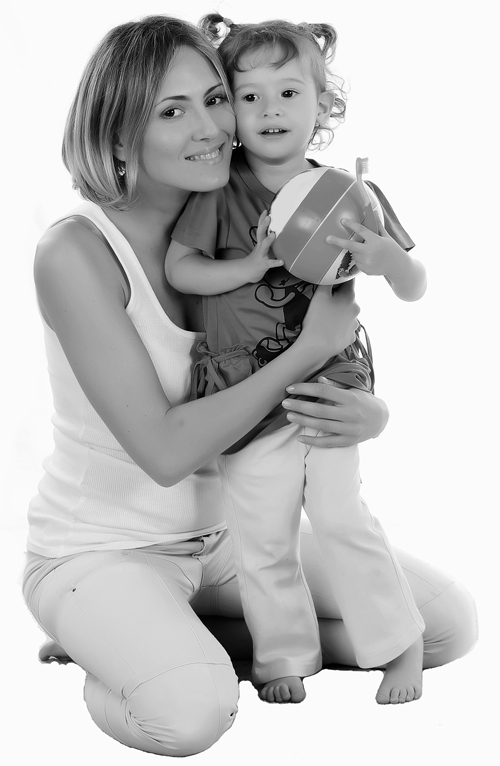
The importance of Mummy friends
I remember when I was pregnant with my first son, a close friend gave me her top baby tip, and that was to make sure I did classes before I gave birth to make new mummy friends. I had at the time thought it was a bit odd. I’d never had to sign up to something before in the hope of meeting people!! But as she was such a good friend, I did as she said, and she was right.
Having and caring for a baby is really wonderful yet everyone has bad days, and as a new mum you can sometimes feel quite isolated and lonely when you’re at home with your baby. The world can sometimes feel as though it’s rushing on past you while you’re getting to grips with being a mummy at home. I found it comforting having a diary scheduled with coffee dates and trips to the park. It’s a chance to get out of the house and speak to others about what you’re going through. The old saying a problem shared is a problem halved is true when you’re going through those early weeks, and it’s really reassuring to know others are going through the same thing as you.
I’m still really good friends with those first mummy friends. You don’t have to meet scores of people, just a couple going through what you are. If you’ve been up a lot in the night, or just having a bad day, a chat over a cup of tea and a piece of cake can make all the difference.

Nutrition for new mums
I asked Laura to tell me her top tips for nutrition after having a baby
Remember back to your pregnancy when everyone asked how YOU were feeling and you had the time to focus on your body and your needs? Once a new baby arrives it’s a different story! So with limited time what are the nutritional priorities to enable a swift post natal recovery and a return to optimal health and well-being?
1) Prioritise meals, especially breakfast – skipping a meal and telling yourself you’ll ‘grab something later’ probably materialises as a less healthy choice as your blood sugar levels plummet and your brain steers you towards high sugar fixes. Grazing on food is tempting, especially when you’re out of routine and tired and a little nearer the fridge than you’re used to! Quick breakfasts packed full of nutrition include fortified wholegrain cereal (which you can always nibble dry), cereal bars (avoid ones coated in yoghurt or syrup), malt loaf, low fat yoghurt and fruit.
2) To help regulate your energy levels stick to 3 meals a day and have a healthy snack if meals are greater than 3-4 hours apart. For main meals why not cook more the night before and re-heat leftovers whilst baby naps. For lighter meals and snacks choose easy wholesome foods – rice cakes, oat cakes or crisp-breads go well with reduced fat hummus, cream cheese or tzatziki and carrot sticks or cherry tomatoes for example –which might be a little easier to munch than a sandwich!
3) Balance meals with wholesome carbs, lean proteins and plenty of fruit and veggies. Don’t be tempted to skip carbs for quick post baby weight loss – whole wheat pasta, wholegrain bread, sweet potato, cous-cous, basmati rice or noodles for example provide your body with essential energy and b vitamins. Proteins include fish, lean meat, pulses or low fat dairy products. Enjoy oily fish once a week to boost omega 3 intake and potentially benefit brain function and don’t neglect red meat, a valuable iron and vitamin B12 source. Dark green leafy veg such as spinach, curly kale and broccoli are an excellent source of folate, low levels of which have been linked to risk of depression.

4) Shop smart – smaller versions of the big supermarkets located on your doorstep are great for everyday essentials and offer a good sense of purpose for early outings with a new-born. Don’t get out of the habit though of weekly shopping involving some meal planning and a shopping list. Keeping consistency to your shopping habits will help ensure a wider variety of food in the diet and easier budgeting. Online shopping is ideal for convenience but once do-able head through the aisles with your baby – early exposure to food selection boosts a healthy curiosity and helps foster a balanced relationship with food long-term!
For more details or to contact Laura, please visit her website www.lecnutrition.co.uk
Breathing in labour
Breathing
Breathing, essential to life and birth, is the core of YogaBirth classes. Over the weeks spent in the class through the practice of simple breath awareness, visualisation and sounding, you will become familiar with the natural rhythm of your breath and increase your ability to focus inward. The repetitious nature of this work is a form of self-hypnosis. When practiced in simple postures this hypnobreathing will enable you to go into the “zone”- a meditative state which is perfect for labour. This practice is healing and calms the busy mind during pregnancy, clearing the way for you to listen to your own intuitive voice. Breath awareness is the background to YogaBirth, so that when the time comes and your body takes over during labour you will instinctively know how to use your breath to soothe, steady and guide yourself through the waves of contractions and breathe yourself to an easier birth.
Coloured ribbon breath visualisation

Take a yawn, release jaw, throat, teeth. Close your eyes. Have your teeth slightly apart, the lips slightly apart.
Watch the easy natural rhythm of your breath.
Allow there to be a very small gap between the top teeth and the bottom of the teeth, between the top lip and the bottom lip. Breathe in through your nose and out through slightly parted lips.
Feel a fine cool breeze passing out between the lips.
Allow the muscles of your face to relax and feel soft. Feel the breath now travelling in through the nose, and out through the mouth.
Allow the breath to be so fine that it feels as a fine thread or ribbon is spinning out between the lips. You can choose whatever colour you would like it to be, golden, silver, purple, blue – any colour you like. It’s smooth, silky, soft and supple, and it is spinning out and out and out with every exhalation.
Allow the exhalation to lengthen each time, without pushing or forcing, but simply letting the out breath increase in length, as the beautiful coloured ribbon or thread of breath spins into the air in front of you.
With each exhalation allow for the breath to go in though the nose and out through the mouth.
Feel the breeze of the exhalation travelling out between the lips, out into the air, in front of your closed eyes.
The exhalation will naturally and inevitably lengthen. Let the end of the silver yarn carry the mental attention farther and farther away with each exhalation. It is as if the final point of the outgoing breath were to carry the mental focus completely out of your body.
The longer the breath – the longer the distance between the mind and the body so your body is left with stillness and quietness. The exhalation releases tension and allows the body to rest. The exhalation is the antidote to pain and tension.
Stay with the moment and rhythm of your own breath.
©Annabel Hargrave
For details of Annabel’s classes please refer to her website http://www.annabel-yogabirth.com/annabel.php or email her hargrave.family@blueyonder.co.uk, or phone 07817931571.
First trip out with your baby
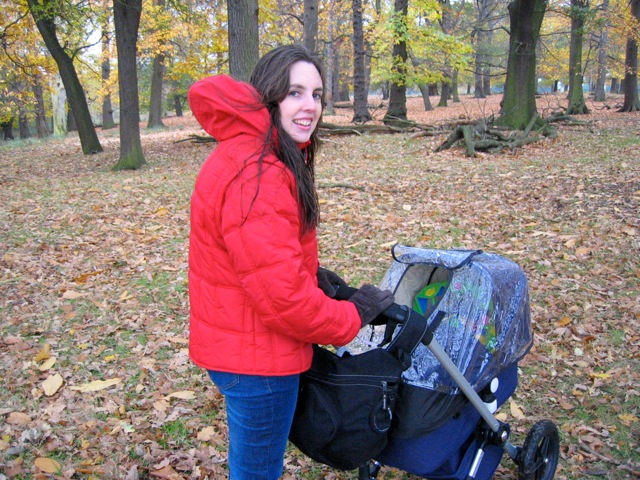
Some new mums find it hard to leave the house in the early days. It can become very easy to stay in all day, with what feels like a constant cycle of feeding, nappy changing and sleeping.
When you do finally venture out, the fresh air and the sheer sense of being out of the house can make you feel a lot better and refreshed.
Here are 10 tips to help
- Make the first journey a short one so you gain in confidence
- Best time to go out is after a feed so you don’t have to stop to feed when you’re out
- Your baby will probably sleep in the pram when you walk around, so if you’re trying to get your baby into a routine, that would be a good time to go.
- Bring a travel changing mat, nappies, wipes and bags just incase you need to change a nappy when you’re out.
- Dress your baby in layers so you can adjust their temperature easily if they get too hot/cold. A spare cardigan helps if it’s a bit colder.
- Bring a muslin incase your baby possets (brings back some milk) when you’re out
- Dress your baby in a hat as they loose a lot of heat through their head.
- Sunglasses can help to protect your eyes as they will be more sensitive from lack of sleep
- Bring the raincover for the buggy and an umbrella
- Bring your mobile if you want to catch up with friends.
Exercising throughout your pregnancy offers great rewards, but how do you make sure that you exercise the right way and what differences should you expect?
Here is an article from Elizabeth Kamm who runs Lovefitbetsy – personal training for pregnancy and post birth. Elizabeth shares her top tips for exercise in pregnancy. Please visit her website www.lovefitbetsy.com for more information.
Why should you continue to exercise in pregnancy?
By strengthening your whole core and pelvic floor muscles means you’re well equipped to cope with the postural changes and growing weight of your uterus throughout your trimesters, as well as the birth itself. By maintaining your fitness and building your energy will also help keep that spring in your step as the trimesters progress.
By guiding mums through pregnancy AND after the big event – I see swift recoveries and mums who are in great shape, ready to embark on the activities of motherhood.
It is recommended that you consult your doctor before embarking on an exercise programme. This is important because your doctor will be able to identify any present or past medical conditions that may affect your own health or health of your baby.
Lovefitbesty’s tips about exercise during pregnancy compared to pre-pregnancy so you know what to expect.
Early Pregnancy
*You have probably already discovered that within these first few weeks you have symptoms which make the idea of exercise about as appealing as "dental work!" These may include fatigue, nausea or simply feeling extremely off-kilter.
LFB TIP: Often a gentle exercise session can alleviate these symptoms and make you feel much better. Listen to your body and be aware of how you feel. If you still don't feel great, slow down and rest if needs be.
As Pregnancy progresses
*You will feel heavier on your feet as your weight increases.
LFB TIP: Low impact exercise coupled with strength work and stretching are ideal at this time. Swimming and stationary cycling can be great options. The increasing weight can make impact exercise, like jogging, uncomfortable. However, you don't have to "hang-up" your running shoes at this time, but it is likely the present body may be more suited to other activities. Listen to your body and if the exercise is not comfortable or feels wrong, replace it with something that feels right.
*Your centre of gravity will start to change with your new weight distribution. This will become more noticeable as your pregnancy progresses. Your posture is likely to alter and correct alignment will feel different. This may also affect your balance.
LFB TIP: Incorporate balance, posture correction and core strength work into your weekly exercise regime. This will help off-set the biomechanical changes you are experiencing, keeping you strong and aligned for every daily life. Note: Core strength work which builds a strong pelvic floor, abdominal muscles and back muscles is key to help you through your pregnancy and will help off-set the common complaints of pregnancy such as lower back pain.
* You may experience areas of tightness as your pregnancy progresses e.g. lower back, shoulders and breasts
LFB TIP: Include gentle stretching for areas that are tight, and work through a comfortable range of movement during exercise. “Stretch the muscles that have become tight and strengthen the muscles that have become weak”. Pregnancy yoga and specialist massage are also great to help alleviate muscle stiffness.
*Joint laxity and flexibility increase due to the presence of pregnancy hormones.
LFB TIP: Throughout your pregnancy, exercise staying pain-free and in a comfortable range, and avoid over-stretching. The pregnancy hormones can remain with you after pregnancy too, so use the same tip during the post-natal period.
*Sweating begins at a lower level of exertion in order to help cooling.
LFB TIP: Have cool water at hand during your exercise session and stay well hydrated (1.5-2 litres per day). Avoid overheating during exercise
*Your respiration rate increases (number of breaths per minute) and the quantity of air taken in with each breath also increases during exercise.
LFB TIP: Move with greater awareness and listen to your breathing capacity during exercise.. The Talk Test is a good indication of exercise intensity - the guideline is not to become over-breathless and to be able to hold a brief conversation whilst exercising.
*You may notice a progressive decline in your aerobic performance as your pregnancy progresses.
LFB TIP: Gently decrease the intensity of your exercise regime as your trimesters progress. This is not a time to increase fitness levels or compete in races. Exercise, in order to maintain your fitness. Note: With regards to exercise intensity, a good rule of thumb is to use a scale between 1-10, where “1” is “sitting at home watching TV” and “10” is working/ exercising at your absolute maximum. When you exercise aerobically, working around a “6” would be a very good level to maintain. Remember, how you feel during exercise after 12 weeks compared to 32 weeks is likely to be different, so a previous “perceived exertion” of “6” is likely to translate to a lower intensity of aerobic exercise at the later stage.
*You might be more conscious of self image.
LFB TIP: Treat yourself to some great maternity sportswear that’s breathable and comfortable to wear. Feel good and embrace this wonderful time.
Third trimester
In your 3rd trimester it is likely you may feel more tired than previously and the extra weight will have an impact on your energy levels and your motivation to exercise.
LFB TIP Be kind to yourself and slowly reduce the intensity of your exercise programme including the type of exercise, duration, weights, exercise repetitions and number of sets. Continue with your aerobic exercise, strength work, core and pelvic floor exercises. Aim to leave every session feeling invigorated rather than drained and exhausted. Incorporate rest, relaxation and restoration into your daily routine. Note: Rotation and twisting should be avoided if the abdominal muscles separate, or you are feeling discomfort.
For further guidance please contact Elizabeth at www.lovefitbetsy.com
When to return to exercise after having a baby?
This article on postnatal exercise is written by Rebecca Bennett of Natus Physiotherapy. She currently offers Postnatal Return to Fitness sessions (see link below).
Early postnatal exercise has many positive effects on our bodies including: increasing confidence, toning weakened muscles like abdominals and pelvic floor, giving you more energy and releasing feel-good hormones. For a lot of new mums, after looking after baby and getting some sleep, returning to exercise is often high on the agenda, but when is it safe to re-start exercise? How often should you be exercising?
Often your doctor, midwife or health care professional may ask you to wait until your 6 weeks postnatal to resume exercise. This can be for a few reasons which include: you will have your 6 week check where they can ask how you are feeling and check your blood pressure, lochia (breakthrough postnatal bleeding) has often stopped by this point, you may have got into a good routine with baby so you can fit in exercise in a more structured way and numerous other reasons. However, The American College of Obstetricians and Gynecologists suggest gradually resuming exercising when you feel up to it, which may be before or well after the 6 week mark.
Here are some things to consider when or before resuming exercise:
· You can start your pelvic floor exercises very soon after giving birth and even though they may feel very difficult to contract or have reduced sensation, persevere, they will help support your bladder when you are exercising and help with healing of any stitches.
· Starting some gentle abdominal exercises as soon as you can is important to give tone to your stomach. At your 10 day health visitor visit, ask them to check for any ‘stomach gap’, formally known as divarication of recti, if the gap is more than 2 fingers widths wide at this check it means some postnatal exercise like sit-ups will be restricted and you should see a women’s health physiotherapist. Some examples of basic abdominal exercises that are safe for everyone include pelvic tilts and static abdominal contractions.
· The type of delivery you have had may restrict how quickly you return to exercise, especially if you have had a c-section, allow your body to recovery for 6 weeks but you can still do pelvic floor exercises, gentle abdominal exercises and walking.
· Try not to start a completely new exercise immediately postnatally, re-start something you have done in the past and gradually increase the intensity of the workout. Listen to your body, if you need to slow down or stop, do so. A good exercise early postnatally is a slow walk which can then be increased to a power-walk and then a jog over time.
· If you would like to go swimming, make sure your breakthrough bleeding has stopped for at least one week, this reduces any infection risk, and in the early stages avoid breast stroke movements as this often puts a strain on your abdominals.
· Always warm up the body before doing exercises with some gentle stretches, and always stop when you feel your body has had enough.
· Have water handy when you are exercising and you may need to drink quite a bit more than usual if you are breast feeding. Sometimes breast feeding before exercise means your breasts are not quite so heavy. Do not forget a well fitting, supportive sports bra!
· The hormone ‘Relaxin’ is released in your blood stream in early pregnancy and affects all of your ligaments by softening them in order to help your pelvis expand. Even though this hormone leaves your system very soon after birth, the effects of this hormone can stay in your system for months. This leaves your body more susceptible to strains and sprains as your ligaments will be looser. Try and keep to flat, even ground and wear good quality, supportive trainers.
· A postnatal exercise class run by a professional will provide safe guided exercises as well as advice and support. An exercise buddy can help keep you motivated.
In conclusion, when to return to exercise postnatally will depend on the individual, what sort of delivery they have had, how easily baby gets into a routine and how you are feeling physically and mentally. In general in the first few days postnatal commence pelvic floor exercises, gentle abdominal exercises and some stretches daily. After a few weeks, either when you feel ready or you have had your 6 week check you can re-start some gentle low impact exercises, listen to your body and then gradually increase as you feel able.
Rebecca Bennett (Natus Physiotherapy)
www.natus-physiotherapy.co.uk
For details of Rebecca’s assessments and treatment sessions, please click here
Why would you do a refresher class if you've got a smaller age gap?
When you start a new business it’s hard to know how best to help people and which class will be most popular.
It made sense to me to offer refresher classes to people on babycare thinking that it’d mostly be those with a larger age gap that would come along.
More recently though, the classes have been popular with smaller age gaps - 2 1/2 and below. These refresher classes are less about babycare as that is still top of mind (and in most cases your firstborn still feels like a baby). Instead the focus of the classes is more about the logistics of managing 2 - how would bath time work and what about bedtime as you can’t split yourself in 2 (although it’d be very handy sometimes if you could!)
Also I’ve had lots of questions about potty training - when is the right time to do it and when you start what are you really letting yourself in for?
Moving to a bed is also a hot topic as many want to free up the cot so as not to have to buy another, but again they want to know what issues might arise if they do this too early?
The thing about a smaller gap between kids is the fact that you’re still very busy with your first - they still need you to do most things for them. (Although on the plus-side they are still usually having a nap or 2 in the day) Therefore you don’t have lots of time to be reading books on what to do through each of the stages and you haven’t had friends go through it yet to help you out.
My 2 hour class is an opportunity to get a practical heads-up on all the things you might be thinking of with your firstborn so that you don’t make things harder for yourself. It’s also an opportunity to think of the practicalities of coping with 2 and how to manage it so that the transition is as smooth as possible.
My first birth experience (7.5 years ago!)and the early weeks with my son

I remember feeling really excited when I was pregnant with my first baby. After my 20 week scan, I felt more confident that things would be OK, and whilst I didn’t know if I was going to have a boy or a girl, I started to think about the things I’d need for the nursery and gearing myself up for the birth.
I found it quite hard knowing what to buy for my baby. There was so much ‘stuff’ out there. The Bugaboo had just come out and at the time everyone thought it looked odd. It was featured in magazines being pushed by the then new mummy Gwyneth Paltrow and was new competition for the popular 3-wheelers. I remember feeling completely confused about what to get. At the time I wasn’t thinking – does it fit in my hallway, can I push it with one hand so I can hold my mobile with the other to speak to my friends/husband. I remember the lady in the shop demonstrating how to fold it down and back up again, but I wasn’t thinking just how many times I’d be doing this and how I really should be paying attention to how small it folded and how much it weighed.
Similarly I didn’t know much about the other things that I needed – yes friends had babies and I loved cuddling them and smiling at them, but in terms of babygrows vs. bodysuits and swaddle robes vs. sleeping bags in addition to everything else, I was pretty clueless.
I had a wonderful birth which I’m sure was down in part to luck, and in part to learning the different birth positions, breathing properly and staying active. I laboured at home for most of the day – getting into the bath as soon as I felt my first contractions, and then using the tens machine and the birth ball until it felt like things were getting more intense. My husband was amazing – I was lucky that I spoke to him before about how I’d like him to help me – not asking me too many questions but just being on-hand if I needed him. When we got to the hospital (over what felt like a hundred speed bumps = not good when you’re contracting!), I remember with amazement when the midwife told me I was 8cms and would I like her to run the water? I was soon in the birth pool, feeling cocooned, and then after a couple of hours, my gorgeous boy was born with the longest eyelashes I’d ever seen. That moment of instant love was completely unforgettable.
I got home early the next day and it was then that I’d realised having a baby was much more than just the birth. I remember looking at our gorgeous boy and wondering what do we do now? I guess I was focusing so much on the birth, that the reality of a baby almost didn’t feel real until that point. I was used to just popping out to get things for 10mins and I wasn’t prepared for how much harder it was to leave the house with my son.
Similarly I was just so shocked by how a little person could cause so much work. I hadn’t really thought through just how long I’d be feeding, and how it could take over my day and night! I was shocked just how simple things you take for granted can change straightaway! I was used to eating when I was hungry and sleeping when I was tired - my son had other ideas!
I’d wished in hindsight that I’d thought more about those early weeks with my son and prepared myself for what it would be like and how I might go about doing things.
When my second son arrived, I felt I had learnt the short cuts and practicalities the hard way. I was so much more prepared this time round and those early weeks were so amazing. Less rushing around and instead concentrating on my beautiful boys.
I started to share my learnings with friends when they became pregnant, and it was them who suggested I set up The Baby Care Company to help other mums and dads-to-be feel more prepared.
The Babycare Company offers a straightforward service based on equipping you with the knowledge and skills you need to thrive as a new mum. Partly, this is about giving you essential information - the things I wished I'd known when I was a young mum. But it's more than this. It's about providing small classes and a supportive environment to give the confidence and encouragement through what is a truly life changing experience.
Mine is a never ending quest to make mums feel happy and confident in those early weeks.
Flying with your baby - some helpful hints
Here’s an interview I did for Ready Steady Mums on flying with your baby for the first time..
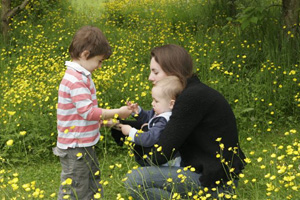
Going on holiday with your new baby is fun, relaxing and joyful... No?
I recently met with Eilish Saba, mother of 2, Oxford University graduate in Physiology, expert in caring for babies and toddlers and founder of The Baby Care Company. We were talking about holidays, and in particular, the challenges of taking a flight with your baby.
Many of our Ready Steady Mums members really look forward to the precious time they have to go on holiday as a family. But how can you make sure it's more fun than fuss? Here is some of Eilish's expert guidance on taking a flight with your new baby.
Q: What should we consider when planning our journey by plane?
Eilish: Your little one will need their own passport. The application process is the same as for an adult passport but they last for 5 years. Getting the photo right when your baby isn’t sleeping or crying can prove a bit of a challenge so give yourself plenty of time.
When booking your flights, give the airline your baby’s details. A child under 2 will be on your knee unless you buy them a separate ticket. For longer journeys ask to book a bassinet which is a small fold down cot, for your baby to sleep in. As numbers are limited, book them as early as you can, and confirm you have one reserved just before you travel.
Q: What should we expect when going through security?
Eilish: You’ll be expected to take your baby out of the buggy, and fold up the buggy to put it through the X-ray machine.
There are still quite strict measures on taking liquids through security but check the latest guidelines before you travel as they change all the time. It’s usually possible to bring breast or formula milk in 100ml quantities. You may be asked to taste your baby’s milk or food to be allowed to take it through.
Just in case, bring an empty sterilised bottle in hand luggage as a spare so in an emergency you can buy pre-mixed formula on the other side of the security gates.
Q: How can we manage the stress of boarding the plane?
Eilish: Some airlines allow parents with small children to board first. But if not, try to relax, hold back and get on the plane after the rush has died down. Older babies can get restless if they board too early and it’s very difficult to get out of your seat whilst others are boarding, so it can sometimes be worth waiting to board.
It’s a good idea to bring your buggy with you on your journey through the airport. Most airlines let you keep them with you until you board the plane and don’t charge for it as extra luggage. You’ll usually get your buggy back when you get off the plane or it’ll be prioritised ahead of the suitcases on the carousel. A sling is also a good accessory to bring to keep your hands free once you get rid of the buggy.
Q: What can we do the make the flight itself easier?
Eilish: Once you’re in your seat, it’s very awkward to move around, and some babies can get frustrated and upset while you wait to take off. Take off and landing can also be hard as babies can be affected by the change in pressure. Try to plan to feed your baby at this time, or use a dummy, to help with equalising. If you’re breastfeeding, it’s worth bringing a blanket for extra privacy and also to ask for a window seat. If you’re formula feeding, pre-mixed formula is easier to use on flights, or measure out your powder beforehand.
Once you are in the air things may calm down and good preparation will help you stay in control.
Compartmentalise your bag so you don’t have to root around for things if you need them in a hurry. Have some wipes, nappies and nappy bags out separately so you don’t have to bring your whole bag to the toilets as there isn’t much room in there. Disposable changing mats are handy as the changing tables can get quite yucky after a longer flight. Oh, and check which toilets have fold down changing tables, to save you queuing at the wrong one!
Dress your baby in layers – so you can add or remove them easily with sudden temperature changes.
Babies often sleep on flights, but if yours doesn’t, taking the baby in the sling and walking up and down the aisle can help settle or entertain a baby. It’s advisable to move around on longer flights anyhow to help prevent DVT.
The cabin crew are usually really helpful when you have a baby on board, so don’t be afraid to ask if you need something.
Q: Do you have a check-list for "what to pack in hand luggage"?
Eilish: As a new parent you’ll be used to bringing the kitchen sink around with you! But here are the essentials.
- Pre-mixed formula milk if not breast feeding.
- Disposable changing mats
- Nappies (lots), wipes, nappy bags
- Pre-sterilised bottles (more than you think you’ll need just in case you’re delayed)
- Some pre-boiled water (this can help sooth baby if there is turbulence and on take-off and landing)
- Bibs
- Muslins
- More than one change of clothes for the baby
- Change of clothes for you (just in case of sick or poo mess!)
- Blanket (the temperature on the aircraft can change quite a lot)
- Disinfectant hand gel
- Plastic carrier bags (for soiled clothes or nappies)
- Dummy (if your baby uses one this can help on take off and landing)
- Tissues
- Sling
- Toys to entertain (book, cuddly toy, rattle, stickers)
Eilish: If you’re planning to hire a car at your destination, make sure you either bring a car seat with you, or hire one in advance. The quality and cleanliness of the hired seats can vary as can the position they rest in the car so bring your own if you’re concerned.
Annoyingly, buggies can be thrown around quite a lot by the baggage handlers, so either take a cheaper travel buggy with you, or make sure yours is packed up carefully. You can usually buy a separate buggy cover which might be a good investment to keep your buggy protected.
Q: Brilliant, we're set for a happy flight! Where can we get more of your tips Eilish?
Eilish: For more helpful tips on caring for your baby please follow us on Twitter:
@TheBabyCareCo
You can email me info@thebabycarecompany.co.uk or call me on 0207 228 1041 with any questions.
Good luck on your first flight together!







